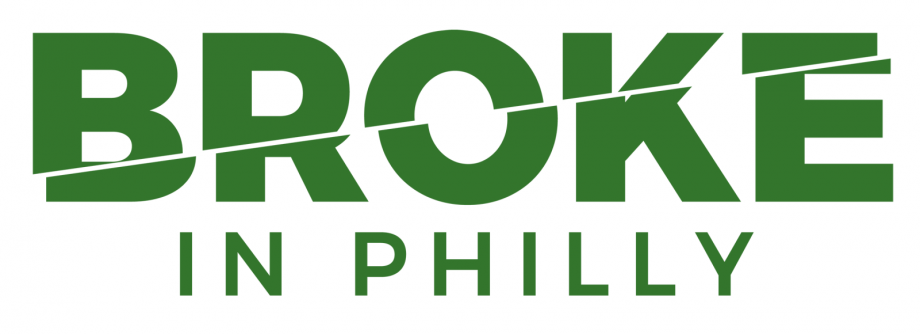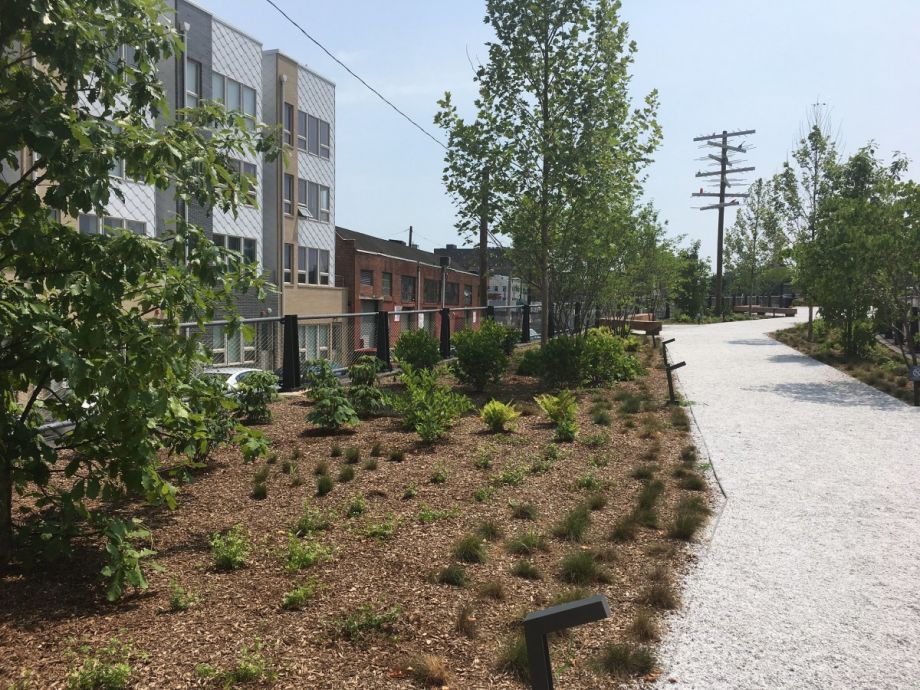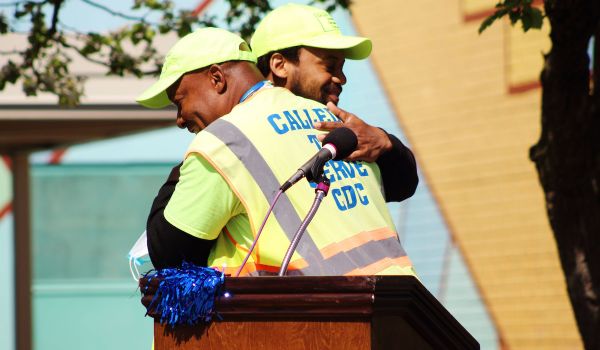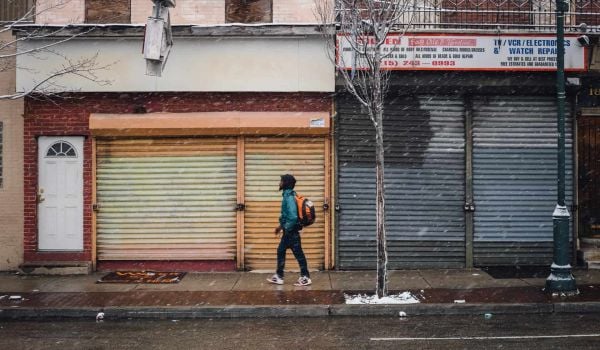EDITOR’S NOTE: This story was originally published by WHYY’s PlanPhilly, and appears here as part of the Broke in Philly reporting collaborative. Next City is one of more than 20 news outlets in the collaborative, a reporting project on solutions to poverty and the city’s push toward economic justice. Follow us on Twitter @BrokeInPhilly.

On a cold Monday morning, Yihua Liu sat on a bench with a friend at the Rail Park. Now a student at Drexel, he’s lived in Chinatown all his life, and he’s noticed the neighborhood changing.
When he was younger, Liu often saw one particular farmer who sold produce out of his red truck. Women from the neighborhood “loved him,” Liu remembers, because he sold it at a great price.
“And, now, I haven’t seen that dude,” Liu said.
Not all the changes are bad, the 19-year-old said. He likes how the edges of the neighborhood look “newer” and “cleaner.” The first phase of the Rail Park, an $11 million public park built on an abandoned elevated railway and widely expected to catalyze a development spree, opened when Liu was in high school. He would cut through the linear park styled after the chic High Line in New York as a shortcut to school.
But Liu hopes the neighborhood doesn’t change too much. He worries if big corporations push out local, Chinese-owned businesses, it will drive residents out as well.
“I want Chinatown to stay the way that it is, to preserve … the culture,” he said. “That’s why my parents like being in Chinatown because whatever they need, they always have.”
Philly’s Chinatown started changing before the Rail Park was planned, says Yue Wu, neighborhood planning and project manager at the Philadelphia Chinatown Development Corporation. But since the first phase opened above Chinatown North and the Callowhill neighborhood in 2018, that change has not slowed down.
“We see a lot of loft development happening from Broad Street towards this neighborhood,” Wu said. “There are more condos development, higher-income people moving into the condos.”
A 2020 study prepared by the consulting firms Strategic Economics and Urban Partners for the Chinatown CDC found that since Friends of the Rail Park — the polished nonprofit that continues to raise money to make the 3-mile park vision a reality — formed in 2013, sale prices of apartment buildings near the first phase of the park grew faster than in the rest of the city. The authors estimated up to 16% of this increase may be attributable to the Rail Park, and projected the amenity could generate more than $2 million in additional real estate tax revenue for the city per year.
Evidence of change is visible all around the first completed section of the Rail Park. On Wood Street, a shuttered tofu factory where the owner hopes to build multi-family housing with a roof deck sits next to a four-story residential building still under construction. A few blocks north on Callowhill Street, workers dart in and out of an open garage door at 988 Trading Company, loading bags of onions and boxes of chicken into trucks. It’s an example of the light industry that has traditionally filled this part of Chinatown — food factories, wholesalers, and sign shops that support nearby restaurants. Beside 988 Trading Company looms a new gray box of a building that houses a climbing gym — an example, Wu said, of the amenities that have popped up to serve the neighborhood’s new residents.
“Currently, if you just look at the neighborhood … you probably can see a diverse mix of businesses and mixed-income population,” she said. “As an urban planning professional, you might think that’s good — it’s good for the neighborhood that you have diversity. But is it going to last?”
Without intervention now, Wu said, more high-income residents could move into the neighborhood, impacting this diversity.
“So the question is, diversity is good, and we want to have the diversity in the neighborhood, and how do we help people who are vulnerable, like low-income and immigrant families and businesses, how can we help them to stay so that we can preserve that diversity?”
Answers to this question could emerge from a planning process Friends of the Rail Park is embarking on, paid for in part by a new grant from the state’s Keystone Communities Program, announced late last month.
Friends of the Rail Park has tried to counter the cultural displacement that can come with gentrification by co-hosting events like Mahjong nights, plant swaps, elder hour — geared toward low-income and low-English language proficiency seniors — said Friends of the Rail Park Director Rebecca Cordes Chan. But the new Equitable Development Plan will probe ways the rail park can counter the economic and physical displacement that comes with gentrification, as it plans to expand the park from Poplar to Brewerytown.
“We need to think about who’s benefiting from this investment? Who pays for it and who decides how this investment is kind of distributed across the neighborhoods?” Chan said.
How to finance equitable development?
The plan may explore whether Friends of the Rail Park could contribute to a land trust, support affordable housing in the neighborhood, or use procurement practices to develop local entrepreneurs in partnership with the nearby Community College of Philadelphia, Chan said. Other possible recommendations include so-called value capture strategies, which siphon off the increases in property value redevelopment creates, and reinvest it in the neighborhood.
“If there is a way to kind of capture that value through probably something like a tax or some other kind of fee, and then to pool those resources and then redistribute them, that’s an example of value capture,” Chan said.
The Keystone Communities Program grant puts $25,000 toward the planning process, but Chan said her organization would like to raise a total of $100,000 for the project. She aims to have an initial draft of the plan finished within the year, but anticipates a multi-year timeline of revision and refinement, similar to the equitable development planning process the 11th Street Bridge Park went through in Washington, D.C.
Fears around gentrification have plagued the Rail Park since its inception, and there’s been talk for years of ways to leverage it and other new amenities to serve long-time residents, particularly low-income immigrant communities.
A proposal for a Callowhill Business Improvement District — which was backed by developer Arts + Crafts Holdings and would have imposed additional taxes on property owners to fund services like street cleaning and lighting — ultimately failed, after a bitter battle pitted it against a larger, PCDC-led Chinatown BID idea and reopened wounds dating back to the 1960s, when the Vine Street Expressway split Chinatown in two. For now, PCDC’s BID effort remains on hold while the organization focuses on helping businesses survive the coronavirus pandemic, Wu said, but the CDC may pursue the idea again in the future.
Another strategy PCDC has recommended is Tax Increment Financing — a tool that’s been used by cities for decades to support development or invest in infrastructure.
Tax Increment Financing, or TIF, requires delineation of a special tax district, where additional revenue collected due to increasing property values is diverted to specific uses, rather than the general fund.
TIFs are often used to encourage private development. Through TIF, a government can use a percent of the increased tax revenue expected from development to back up bonds to build roads or remediate contamination, making development easier, or can use the money to reimburse private developers for investments. From a developer’s perspective, TIF is a way to redirect the increasing taxes on the property they’re building back to the cost of construction.
TIF districts have helped pay for the entertainment, retail, and housing complex in D.C.’s Chinatown known as Gallery Place, the Red Wings hockey stadium in Detroit, and the flagship REI store in Denver.
In Philadelphia, there are about a dozen TIF districts already in existence, but the tool is mainly used to incentivize private development, and many have not met their projected revenue goals. A large portion of the city’s TIF districts was created in the 1990s when Ed Rendell was mayor and Philadelphia was aggressively courting private development after decades of corporate flight. Fewer have been approved during each successive administration, said Sam Rhoads, executive vice president at PIDC. None of the TIF districts created to date in Philadelphia have funded community benefits, according to the 2020 Strategic Economics report.
A recent TIF example in Philly is the redevelopment of The Gallery at Market East, now the Fashion District. The project was approved for a 20-year TIF district in 2015, saving the mall’s owners $55 million in property taxes.
Before that, a TIF district created in 2013 offset $33 million in project costs for the W Hotel in Center City.To accomplish equitable development goals, a Rail Park TIF would need to work differently, PCDC officials say. Rather than simply offset project costs, the TIF they envision would facilitate community-oriented investments that help keep the neighborhood affordable for low-income and immigrant residents — specifically, mixed-use development incorporating affordable housing and retail space.
A TIF district created in Chicago’s Chinatown in the 1980s aimed to help the neighborhood expand, paying to build a system of roadways to support new development. Another TIF district approved there in 2013 helped fund a new library. The city of Portland sets aside a portion of TIF funds in urban renewal areas to develop and preserve affordable housing, as well as provide home repair grants for low-income homeowners. A 2020 report prepared for PCDC by researchers at PolicyLink and Sarah Yeung of Sojourner Consulting highlights the Oregonian policy as an example of the opportunity TIF presents to “advance racial and economic equity.”
“When you have a lot of development potentials in the neighborhood, most of the times that benefits investors and developers,” Wu said. “On the other hand, the lower-income residents who are tenants do not benefit from those value increase. So, the goal is to capture some of the rise in property value so that it can be reinvested to benefit people who were harmed by the improvements.”
In Philadelphia, creating a TIF district requires support across the political spectrum. City Council and the school must approve legislation outlining the bounds of the district and the use of the revenue collected. The city’s public-private economic development corporation, PIDC, manages the process, and can bring proposals from property owners or community groups to the council and the school district for approval. The development corporation is also the entity that holds and distributes the TIF funding for the uses prescribed in the legislation.
There are limitations to where TIF districts can be used. Under Pennsylvania’s TIF statute, they can only be used in areas designated as “blighted,” as defined in the state’s Urban Redevelopment Law. Historically, PIDC only facilitates the creation of TIF districts where development would not occur without it, said Rhoads.
Chan, with Friends of the Rail Park, said the group is open to investigating value capture strategies such as TIF and Business Improvement Districts, but can’t commit to supporting either before the Equitable Development Plan is finished.
These options are not the only solutions PCDC is pushing. Wu is also eying inclusionary zoning, a policy that requires developers set aside a certain percentage of new housing they create as affordable. City Council passed a bill mandating the policy in North, West, and Northeast Philadelphia at the end of last year.
The path to making these interventions a reality lies in increased advocacy, Wu said. PCDC has started building up community leadership, recently recruiting and training a group of eight residents to become community advocates. But an equally important step, Wu said, is finding the right solutions for the community.
“There are many factors,” Wu said, “whether there are political support and whether it makes sense for the neighborhood.”
Sophia Schmidt covers the environment for WHYY’s PlanPhilly. Before coming to Philadelphia in 2021, Sophia reported on her home state of Delaware for Delaware Public Media and produced interviews for NPR’s “Weekend Edition.” Sophia was a 2021 Metcalf Fellow.
















